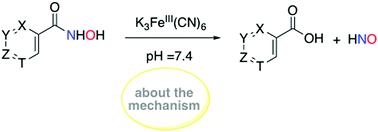Mechanistic insights into the in vitro metal-promoted oxidation of (di)azine hydroxamic acids: evidence of HNO release and N,O-di(di)azinoyl hydroxylamine intermediate†
Abstract
The oxidant-dependent ability of hydroxamic acids to release nitroxyl (HNO), a small inorganic molecule endowed with various biological properties, is addressed from a mechanistic standpoint. Indeed, the exact mechanism of the hydroxamic acid oxidation in physiological conditions and the direct or indirect characterization of the intermediates remain elusive. In this work, intermolecular oxidation of isonicotino-, nicotino- and pyrazino-hydroxamic acids with K3[FeIII(CN)6] at physiological pH (7.4), was monitored by 1H NMR, MS, EPR and UV-vis techniques. While nitrosocarbonyl (di)azine intermediates, (di)Az-C(O)-NO, could be a priori envisaged, it was in fact the corresponding N,O-di(di)azinoylhydroxylamines (AzC(O)NHOC(O)Az) and HNO that were identified, the first by 1H NMR and the second on the basis of EPR and UV-vis experiments using the [2-(4-carboxyphenyl)-4,4,5,5-tetramethylimidazoline-1-oxyl-3-oxide] (cPTIO) spin trap. The decomposition of the unstable N,O-di(di)azinoylhydroxylamine intermediates in aqueous buffer media was shown to generate the corresponding carboxylic acids as final organic products, envisaged as possible in vivo metabolites. The same oxidation experiments performed in the presence of methylamine led to the corresponding N-methyl amides suggesting that, unlike hydroxamic acids, N,O-di(di)azinoylhydroxylamines act as acylating agents in physiological pH conditions.



 Please wait while we load your content...
Please wait while we load your content...